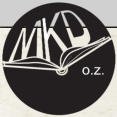

MUZEOLÓGIA
MUSEOLOGY
a kultúrne dedičstvo
and Cultural Heritage

News
Journal Muzeológia a
kultúrne dedičstvo -
Museology and Cultural
Heritage:
SJR 2024: 0,424 (Q1)
Museology SJR rank: 8/83 (Q1) Conservation SJR rank: 11/103 (Q1)JIF WoS 2023: 0,6
JCI WoS 2023: 1,28, Q1 ESCI: 49/411 (Q1)New issue
Muzeológia a kultúrne
dedičstvo 2/2025
online New volume Studia Museologica Slovaca, vol. 8 (2024) online New volume Populačné štúdie Slovenska 17 (2024) onlineNew book
P. Tišliar (ed.). Osobnosti uměleckoprůmyslového muzejnictví (2025) online
Contents 1/2024
Title: National identity in the exhibition of the Silesian museum: A case study based on the
methodology of dispositive analysis
Abstract: This study presents research on the exhibition Encyclopaedia of Silesia at the Silesian Museum in Opava. The aim of the
research was to identify the form of Czech national identity that is constructed and reconstructed by this exhibition, by focusing on the
elements and narratives through which Czech national identity is presented and constructed. It also examines whether these elements
replicate the prevailing ideas and stereotypes related to this identity in society. The research takes the form of a case study based on
dispositional analysis, and showed that the narrative of Czech national identity appears in the exhibition. This confirmed that national
identity can emerge not only in national museums but also in other types of museum – in this case a regional museum in which
national and regional identities are intertwined.
Author: Kolaříková, Veronika
Publication order reference: Masaryk University, Faculty of Education, Department of Social Education, Czech Republic, e-mail:
kolarikova.veronika@mail.muni.cz, https://orcid.org/0000-0001-7726-6913
Source: Muzeológia a kultúrne dedičstvo, year: 2024, vol.: 12, issue: 1, pages: 5-27.
Key words: national identity, museum exhibition, case study, dispositive analysis, Silesian museum
Language: English
online full-text PDF
doi: 10.46284/mkd.2024.12.1.1
Title: Museum presentation and new trends in exhibition displays from a museological perspective
using the example of selected European university museums and collections
Abstract: Against the background of museological theory, this paper questions new trends in current museum exhibition displays,
focusing on universities as institutions of higher education and as preservers of cultural heritage. The first part of this paper provides
an overview of university heritage, its scale and scope and the labels of heritagisation that can be linked to it. In the second part of the
paper, select examples of university exhibitions are introduced – each of which dealing with a specific university heritage. These
examples are all part of the Coimbra Group network of universities, which includes some of the oldest universities in Europe. The
exhibitions are analysed in terms of their forms of presentation, the way in which they deal with objects as evidence for university
history and the communication modes they use.
Author: Biedermann, Bernadette
Publication order reference: University Museums, University of Graz, Attemsgasse 8/III, 8010 Graz, Austria, e-mail:
bernadette.biedermann@uni-graz.at, https://orcid.org/0000-0001-5042-6008
Source: Muzeológia a kultúrne dedičstvo, year: 2024, vol.: 12, issue: 1, pages: 29-44.
Keywords: war, museum presentation, museology, university museums, university collections on display
Language: English
online full-text PDF
doi: 10.46284/mkd.2024.12.1.2
Title: Samuel Niedenthal and the Legacy of Zoology in the Seventeenth Century
Abstract: The aim of this study is to analyse the extensive collection of the zoological drawings by Samuel Niedenthal that has been
preserved in Dresden. They were executed using various techniques and depict a variety of animal species. This article draws
attention especially to studies of the local fauna. This legacy of Pomeranian zoology is unique and important given the destruction of
the painter’s artistic oeuvre, but also because it illustrates development of science in his time. Niedenthal’s depictions of animals, birds
and insects are the first such complete compendium created in in seventeenth-century Central Europe. The detailed and accurate
pictures make it possible to identify species occurring in the area, representing the first records of them in Pomerania.
Authors: Sobecka, Anna; Szwedo, Jacek
Publication order reference: University of Gdańsk, Institute of Art History, Bielańska 5, 80-952 Gdańsk, Poland, e-mail:
anna.sobecka@ug.edu.pl, https://orcid.org/0000-0001-8234-0559; University of Gdańsk, Laboratory of Evolutionary Entomology and
Museum of Amber Inclusions, Department of Invertebrate Zoology and Parasitology, Wita Stwosza 59, 80-308 Gdańsk, Poland, e-mail:
jacek.szwedo@ug.edu.pl, https://orcid.org/0000-0002-2796-9538
Source: Muzeológia a kultúrne dedičstvo, year: 2024, vol.: 12, issue: 1, pages: 45-61.
Keywords: Samuel Niedenthal, drawings collection, early modern zoology, animals, insects
Language: English
online full-text PDF
doi: 10.46284/mkd.2024.12.1.3
Title: Preservation of cultural diversity and current tools of monument care
Abstract: This article deals with cultural sustainability, authenticity and one of its basic pillars: the preservation of diversity. It looks at
constructions around the world and how they have adapted to local geophysical circumstances, both in the construction methods and
materials used. It analyses how diversity has been endangered by globalisation in the territory of Slovakia and elsewhere.
Subsequently, the article focuses on monument care and preservation in Slovakia and other countries, comparing the legal
instruments used in different countries. The article proposes a system for the categorisation of objects built before 1947 in Slovakia.
This is key to better understanding the topic of protection of heritage buildings for professionals and government agencies dealing with
monument protection. The proposed categorisation could help significantly in systematising the protection of tangible cultural heritage
and building culture in Slovakia.
Authors: Ruhigová, Ema; Ruhig, Roman; Gregorová, Jana
Publication order reference: Slovak University of Technology in Bratislava, Faculty of Civil Engineering Department of Architecture,
Radlinského 2766/11, 810 05 Bratislava, Slovak Republic, e-mail: ema.ruhig@stuba.sk, https://orcid.org/0009-0005-2825-8796; e-
mail: roman.ruhig@stuba.sk, https://orcid.org/0009-0004-3893-843X; e-mail: jana.gregorova@stuba.sk, https://orcid.org/0009-0009-
7226-9459
Source: Muzeológia a kultúrne dedičstvo, year: 2024, vol.: 12, issue: 1, pages: 63-83.
Keywords: monument care, monument protection, monument law, cultural sustainability, traditional architecture, vernacular
architecture, preservation of diversity, cultural diversity, authenticity, globalization, categorisation of monuments, national cultural
monument
Language: English
online full-text PDF
doi: 10.46284/mkd.2024.12.1.4
Articles (Abstracts)

Full-text version
DOI:10.46284/mkd.2024.12.1.0
ISSN 1339-2204
eISSN 2453-9759
EV 1/22/EPP
Vol. 12 (2024), No. Is. 1



























